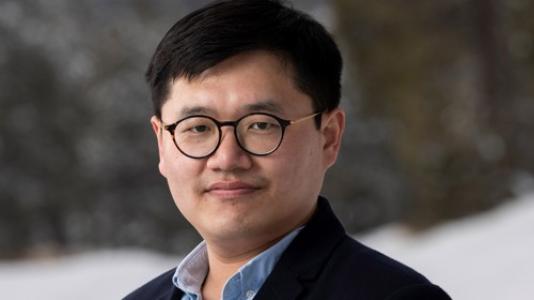Tsai receives 2020 Rosalind Franklin Young Investigator Award

Hsinhan (Dave) Tsai of the U.S. Department of Energy’s (DOE) Los Alamos National Laboratory is the 2020 recipient of the Rosalind Franklin Young Investigator Award.
This biannual award is given by the Advanced Photon Source (APS) Users Organization to recognize important scientific or technical accomplishments at (or beneficial to) the APS by a young investigator, typically a senior graduate student or early career Ph.D. The APS is a DOE Office of Science User Facility located at DOE’s Argonne National Laboratory. The award is named for Rosalind Franklin, a chemist who played a critical, but largely unacknowledged role in the discovery of the structure of DNA.
Tsai, a J. Robert Oppenheimer Distinguished Postdoc Fellow at Los Alamos National Laboratory, was nominated for this award by Joseph Strzalka of the Argonne X-ray Science Division, Dynamics and Structure group. In his nomination form, Strzalka noted Tsai’s “prolific record of high-impact achievements, driving innovations in instrument capabilities and fostering new collaborations.”
“It’s my greatest honor to be recognized for my work with the Rosalind Franklin Young Investigator Award,” Tsai said. “Without the resources of the APS and help from talented, motivated and hardworking APS scientists, we could not achieve such productive work and continue to push the boundaries in grazing-incidence scattering techniques.”
Tsai’s work at the APS centers around fundamental materials science, including finding new applications for perovskite (a compound with a specific calcium titanium oxide structure) semiconductors. These materials can be used for optoelectronics (including LED lights and photovoltaics), energy storage, quantum and spin device applications. His work also explores other novel properties in 2D quantum materials.
Tsai received his Ph.D. in materials science and nanoengineering from Rice University, his M.S. in polymer chemistry from the Institute of Organic and Polymeric Materials at National Taipei University of Technology and his B.S. in chemistry from Fu Jen Catholic University. During his Ph.D. studies, he developed a new approach to obtaining high-quality 2D and 3D thin perovskite films for high-performance electronic device operation. His current work involves integrating 2D organic-inorganic hybrid perovskite films into functional devices, such as high-energy radiation detectors and lighting devices.
In 2012, Tsai received a Los Alamos Distinguished Performance Award for Small Teams for his contribution to new sensor applications as well as a Graduate Student Gold Award from the Materials Research Society for his “particularly significant and timely research” of hybrid perovskites materials and their applications in LEDs and photovoltaics in 2018.
About the Advanced Photon Source
The U. S. Department of Energy Office of Science’s Advanced Photon Source (APS) at Argonne National Laboratory is one of the world’s most productive X-ray light source facilities. The APS provides high-brightness X-ray beams to a diverse community of researchers in materials science, chemistry, condensed matter physics, the life and environmental sciences, and applied research. These X-rays are ideally suited for explorations of materials and biological structures; elemental distribution; chemical, magnetic, electronic states; and a wide range of technologically important engineering systems from batteries to fuel injector sprays, all of which are the foundations of our nation’s economic, technological, and physical well-being. Each year, more than 5,000 researchers use the APS to produce over 2,000 publications detailing impactful discoveries, and solve more vital biological protein structures than users of any other X-ray light source research facility. APS scientists and engineers innovate technology that is at the heart of advancing accelerator and light-source operations. This includes the insertion devices that produce extreme-brightness X-rays prized by researchers, lenses that focus the X-rays down to a few nanometers, instrumentation that maximizes the way the X-rays interact with samples being studied, and software that gathers and manages the massive quantity of data resulting from discovery research at the APS.
This research used resources of the Advanced Photon Source, a U.S. DOE Office of Science User Facility operated for the DOE Office of Science by Argonne National Laboratory under Contract No. DE-AC02-06CH11357.
Argonne National Laboratory seeks solutions to pressing national problems in science and technology by conducting leading-edge basic and applied research in virtually every scientific discipline. Argonne is managed by UChicago Argonne, LLC for the U.S. Department of Energy’s Office of Science.
The U.S. Department of Energy’s Office of Science is the single largest supporter of basic research in the physical sciences in the United States and is working to address some of the most pressing challenges of our time. For more information, visit https://energy.gov/science.